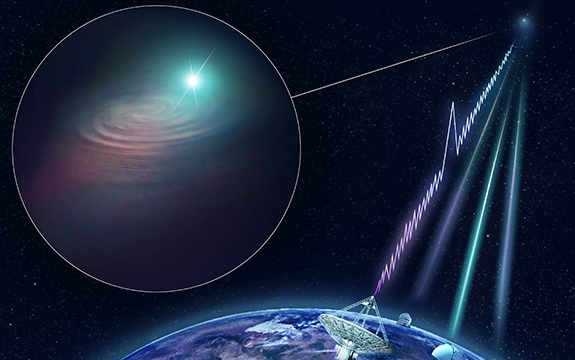Australian-led team of astronomers make history in a split second

In Summary
- An Australian-led, international team of astronomers is the first to discover the precise location of a powerful one-off burst of cosmic radio waves known as ‘fast radio bursts’
- The burst has been localised to a large galaxy about 4 billion light-years away
- Cause of fast radio bursts remains unknown, but determining their exact location is a key step towards solving this mystery
In a world first, an Australian-led, international team of astronomers has determined the precise location of a powerful one-off burst of cosmic radio waves known as ‘fast radio bursts’.
The discovery was made by a team, including Swinburne astrophysicists Dr Adam Deller and Dr Ryan Shannon, using CSIRO’s new Australian Square Kilometre Array Pathfinder (ASKAP) radio telescope in the Western Australian outback.
The galaxy from which the burst originated was imaged by three of the world’s largest optical telescopes, with the results published online in Science today.
A big breakthrough
“This is the big breakthrough that the field has been waiting for since astronomers discovered fast radio bursts in 2007,” says CSIRO lead author Dr Keith Bannister.
In the 12 years since then, a global hunt has netted 85 of these bursts. Most have been ‘one-offs’, but a small fraction are ‘repeaters’ that recur in the same location.
Fast radio bursts last less than a millisecond, making it difficult to accurately determine where they come from.
In 2017, astronomers found a repeater’s home galaxy. However, localising a one-off burst has been much more challenging.
Dr Bannister’s team developed new technology to freeze and save data from the new CSIRO telescope less than a second after a burst arrives at the telescope.
This technology was used to pinpoint the origin of the fast radio burst, identified as the outskirts of a galaxy just smaller than the Milky Way, about 4 billion light-years away.
"If we were to stand on the Moon and look down at the Earth with this precision, we would be able to tell not only which city the burst came from, but which postcode – and even which city block,” says Dr Bannister.
The CSIRO telescope used is made up of multiple dish antennas. The burst had to travel a different distance to each dish, reaching them all at a slightly different time.
Swinburne astrophysicist and discovery team member, Dr Adam Deller, says: “From these tiny time differences – just a fraction of a billionth of a second – we identified the burst’s home galaxy and even its exact starting point, 13,000 light-years out from the galaxy’s centre in the galactic suburbs.”
Bursting away from home
To find out more about the burst’s home galaxy, the team imaged the galaxy and measured its distance using sensitive optical telescopes located throughout the world.
The only previously localised burst, the repeater, comes from a tiny galaxy that is forming lots of stars.
Dr Deller says the burst the team has localised, and its host galaxy, looks nothing like the ‘repeater’.
“It comes from a massive galaxy that is forming relatively few stars. This suggests that fast radio bursts can be produced in a variety of environments, or that the seemingly one-off bursts detected by the ASKAP telescope are generated by a different mechanism to the repeater.”
The cause of fast radio bursts remains unknown, but the ability to determine their exact location is a key step towards solving this mystery.
Team member Dr Jean-Pierre Macquart from Curtin University says these bursts are altered by the matter they encounter in space.
“Now that we can pinpoint where they come from, we can use them to measure the amount of matter in intergalactic space.”
This would reveal elusive intergalactic material that astronomers have struggled to locate.
Swinburne and fast radio bursts
The localisation of the radio burst was done as part of a project that is jointly led by Dr Bannister, Dr Macquart and Swinburne’s Dr Shannon.
Dr Shannon and CSIRO’s Dr Shivani Bhandari carried out the observations and were the first to spot the burst.
Last year, Dr Shannon led the discovery of 20 fast radio bursts, nearly doubling the known number of fast radio bursts.

